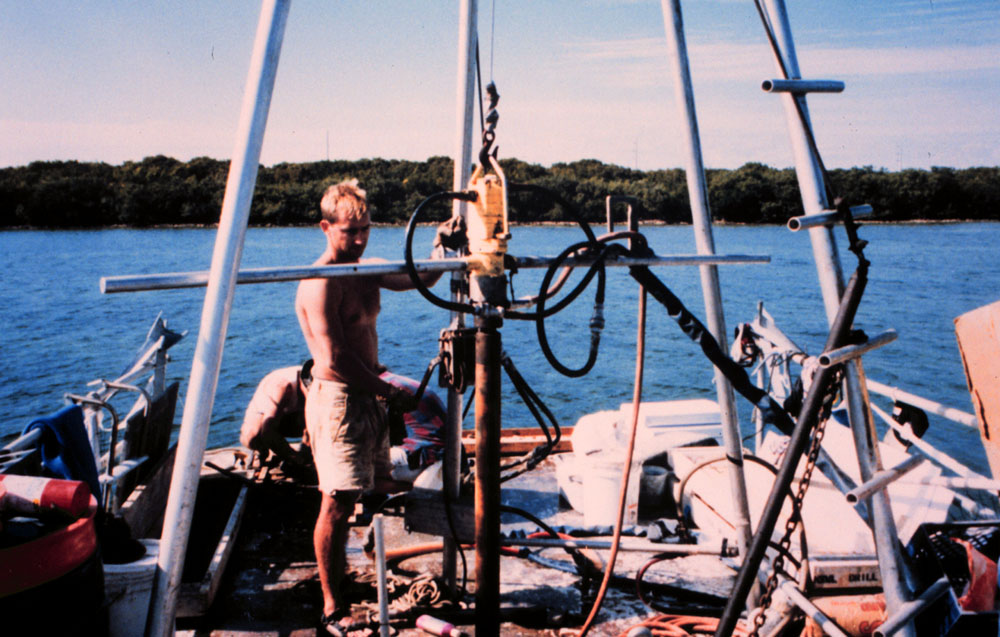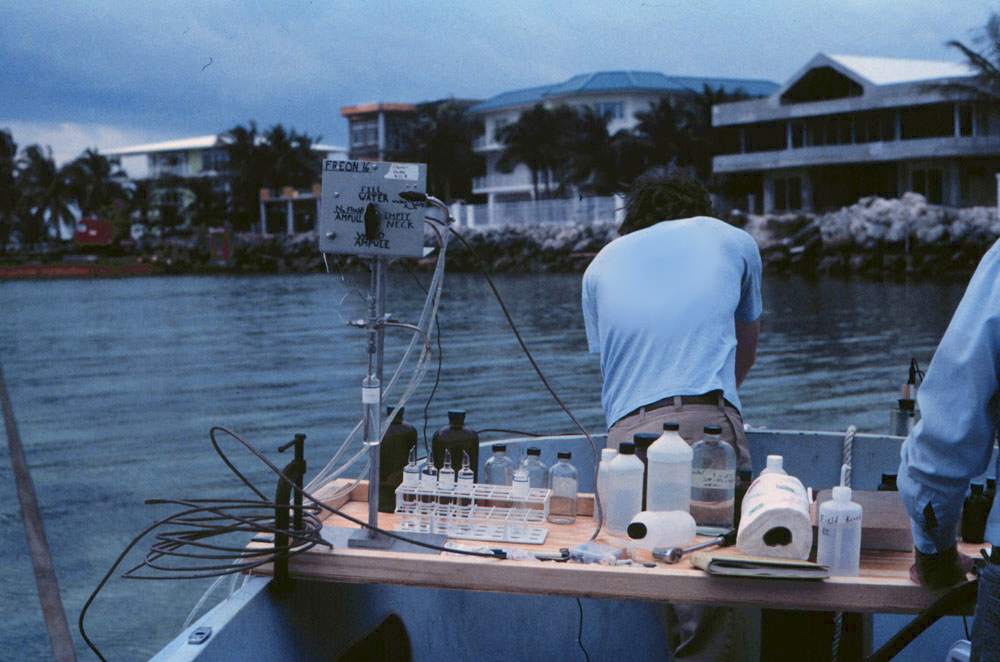South-Florida Eco-System Study
In This Document
Summary
Ground water is a potential source, sink, and carrier of nutrients and other contaminants beneath the Florida Keys and nearby offshore regions. Ground-water flow patterns and nutrient sources need to be understood to assess and predict the dispersal of anthropogenic contaminants such as injected waste water. Small-scale tracer studies indicate rapid local lateral movement of ground water near the Keys, and water-level monitoring studies indicate hydraulic potentials for ground-water flow. Those results, however, do not address directly the large-scale extent of ground-water transport and the origin of nutrients observed in offshore ground water. A variety of environmental isotopes and geochemical tracers are being used to provide information on the sources, flow directions, exchange rates, and chemical characteristics of ground water underlying the region at depths of about 3 to 20 m below the sediment surface. In this study we used a multi-tracer approach to address a variety of scientific problems: (1) salinity data combined with stable H and O isotopes of water provide information about ground-water sources; (2) CFCs, 3H, and He isotopes provide information about the subsurface residence times of ground water; and (3) 14C and stable isotopes of C-, N-, and S-bearing constituents provide information about sources of solutes, and chemical reactions among ground water, nutrients, and aquifer materials. Two major offshore sampling surveys were completed in 1996 and 1997, and additional samples were obtained from wells on land in 1998. In total, these constitute a set of representative samples of surface water and ground water from a large part of Florida Bay, the Keys, and offshore areas extending to the reef tract in the south.
Stable H- and O-isotope ratios and salinities indicate at least 4 mixing components: seawater, meteoric water, evaporated seawater, and evaporated meteoric water. Isotopic data for tap water, waste water, and injected waste water all were consistent with a common fresh-water source on the Florida mainland, and with mixing of waste water and bay-type marine ground water in the subsurface near waste-water injection sites. Atlantic ocean-side ground water had values of δ2H (+10 ± 2 ), δ18O (+1.15 ± 0.15 ), and salinity (35 ± 1 ) that generally were equal to those of offshore seawater. Those results are consistent with Atlantic ocean-side ground water having originated from recharge of normal seawater. Bay-side ground water generally had higher values of δ2H (+13 to +20 ), δ18O (+1.5 to +2.7 ), and salinity (35-39 ) compared to offshore seawater, with the highest values occurring in the eastern part of the bay and more marine values toward the west. The regional patterns of H and O isotope variations in bay-side ground water are similar to the patterns in bay-side surface water. Those results are consistent with the bay-side ground water having originated from recharge of evaporated bay water during times of high bay salinity, and they indicate little regional-scale lateral ground-water transport beneath the bay. ground-water samples from beneath the Keys and from short distances (less than a few hundred meters) offshore to the south had isotopic compositions consistent with transport of bay water toward the ocean side in the subsurface. However, the salinity and isotope results so far have not supported long-distance transport (more than a few hundred meters) of bay-derived ground water to sites far offshore on the Atlantic ocean side (for example, to the reef) within the depth range investigated.
Concentrations of CFC-12 in marine ground water on both sides of the Keys were consistent with atmospheric equilibration and subsequent isolation (recharge) at times ranging from 0 to more than 50 years ago. Degradation may have altered significantly the concentrations of CFC-11 and CFC-113 in most samples. Minor CFC contamination was detected in water from a canal on Key Largo and in waste water at the Keys Marine Laboratory, but it did not appear to be widespread. Apparent recharge ages derived from analyses of 3H and He isotopes ranged from 0 to more than 30 years, and reconstructed values of initial 3H were in the range of 0-10 TU. 3H-3He ages and CFC-12 ages were generally correlated, but the CFC-12 ages commonly were on the order of 10-50 % older than those ages based on 3H-3He. Apparent ages derived from both CFC and 3H-3He methods were stratified. Wherever more than one depth could be sampled at the same site, the deeper water appeared to be older. Estimated concentrations of non-atmospheric radiogenic 4He were on the order of 0-1 x 10-8 ccSTP/g (cc at Standard Temperature and Pressure/g). The δ13C values of dissolved inorganic carbon (DIC) indicate varying contributions from both organic carbon oxidation and carbonate mineral recrystallization. Un-normalized 14C abundances in DIC (mainly bicarbonate) range from less than 10 % to about 115 % "modern", consistent with a large range of apparent radiocarbon ages. Much of the variation in apparent ages, however, can be accounted for by chemical reactions between seawater with high 14C and carbonate sediments with low 14C. Combined results of chronologic tracers indicate that the time scales of ground-water/surface-water exchange are on the order of years to decades at depths up to about 20 m below the sediment-water interface. Within those time scales, ground-water compositions are altered significantly by ground-water-aquifer interactions that may include release or consumption of nutrients.
Nutrient analyses confirmed that anoxic marine ground water throughout the area contained significant amounts of ammonium (10-80 µM). Concentrations of sulfide, methane, and bicarbonate also were elevated in the reduced water samples. The δ15N values of ammonium in ground water near a site where treated sewage effluent is injected to the ground-water system were high (+9 to +12 ) and could be consistent with a waste-water source. The δ15N values of ammonium in all other ground water were low, but variable (+3 to +8 ). There was not a strong correlation between ammonium concentrations and δ15N values. It is possible that much of the ground-water ammonium was produced naturally by anaerobic degradation of N-bearing organic matter in sediments. Nitrate concentrations in most samples were low (< 1 µM). Nitrate concentrations greater than 5 µM were detected in waste water and in ground-water samples that contained low-salinity components either from waste water or from precipitation recharge. The highest nitrate concentrations were measured in treated waste water and in shallow mixtures of waste water and saline ground water. A minor source of N also was identified in the Keys water supply. Concentrations and isotopic compositions of dissolved nitrogen gas in most ground water were generally consistent with atmospheric equilibration between 20 and 28°C before recharge. There was evidence in some samples for small quantities of excess N2 that may have been derived from denitrification (reduction of nitrate to N2). Excess N2 in waste water and in mixtures of ground water and waste water near an injection site was apparently the result of denitrification of nitrate in the waste water.
This project is providing quantitative information about the origins, residence times, and nutrient characteristics of marine ground water beneath the Florida Keys and nearby offshore areas. Chronologic and isotopic data for ground water are useful in assessing the extent and rate of movement of potential contamination in the subsurface. Nutrient chemistry and isotopic data are useful in distinguishing natural and anthropogenic sources of chemical constituents in ground water. These data and interpretations aid decision-making about waste-water treatment and disposal in the region. In addition, the study includes testing some new combinations of methods and sample types that could expand the list of approaches available to the scientific community for future investigations of similar problems.
Photos

Installation of shallow piezometers in the Atlantic shelf near Key Largo, FL

Sampling a shallow piezometer in Florida Bay near Key Largo
Investigators
J.K. Böhlke, L.N. Plummer, E. Busenberg, and T.B. Coplen (U.S. Geological Survey, 432 National Center, Reston, VA 20192), E.A. Shinn (U.S. Geological Survey, St. Petersburg, FL 33701),and P. Schlosser (Lamont-Doherty Earth Observatory of Columbia Univ., Palisades, NY 10964)